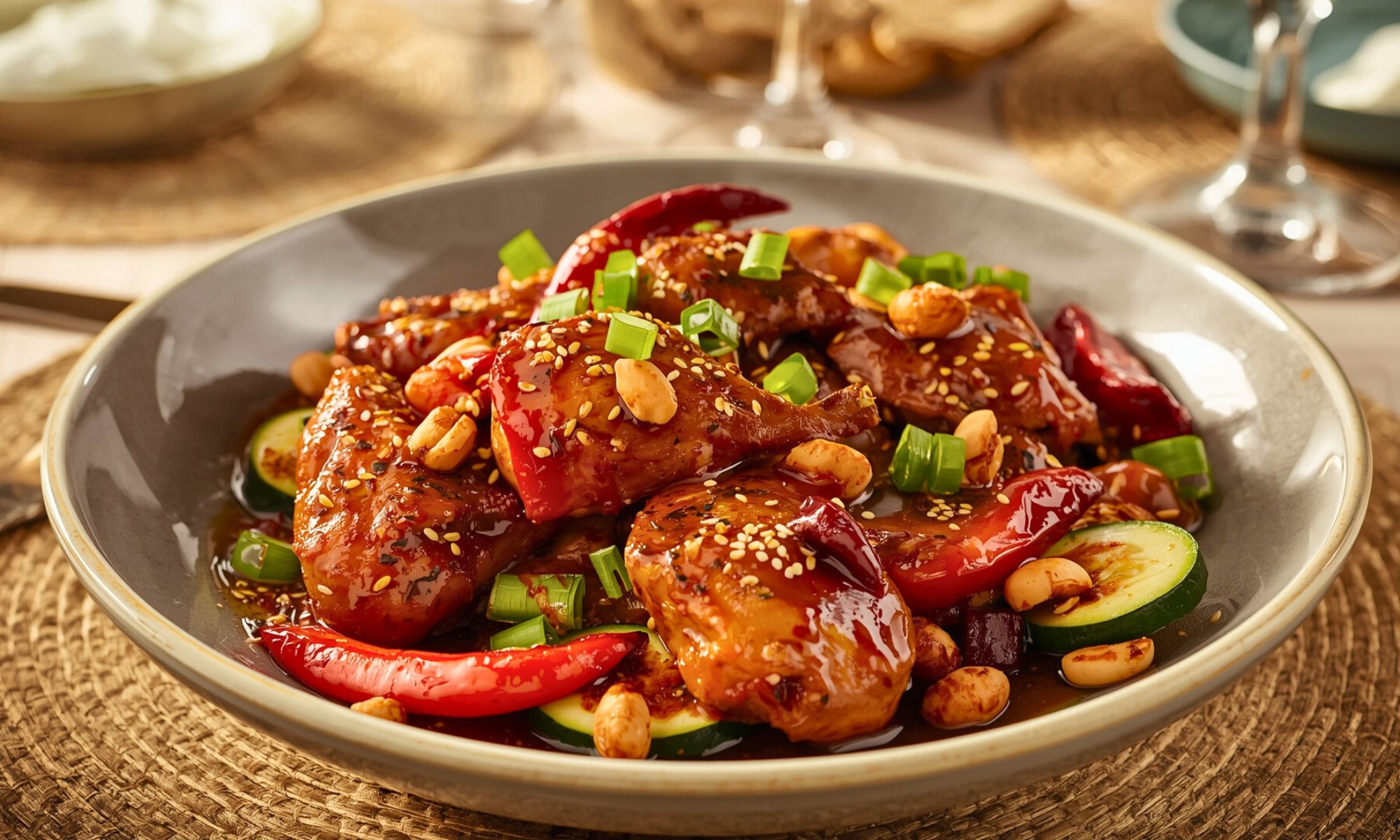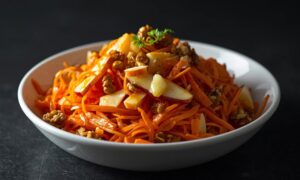It wasn’t the missing groceries or the clock hitting way past dinnertime that got me, it was the boredom. Another bland “just throw it together” meal felt criminal after a day already robbed of energy. You know that moment when takeout sounds tempting, but your wallet (and patience) vote no? That’s when I tossed a few stray peppers, a splash of soy, and chicken straight into the slow cooker. Not a chef’s grand plan, just a late night gamble that smelled way better than it had any right to.
By the time the sauce bubbled into that sticky sweet heat, I was hooked. The garlic practically announced itself, the peppers softened into glossy jewels, and the whole kitchen felt alive again. What landed on my plate wasn’t just dinner, it was bold, fiery, and oddly comforting, like the grown up version of takeout you wish you’d been ordering all along.
Stick with me, because I’ll show you exactly how to bring this Crockpot Kung Pao Chicken to life, with shortcuts, swaps, and serving tricks that turn weeknight chaos into something that actually feels worth the fork. Trust me, this one’s going into your repeat rotation.
What Makes This Crockpot Kung Pao Chicken Special
Traditional kung pao gets its soul from the balance of sweet, sour, salty, and spicy. We’re keeping all that, but letting time do the heavy lifting instead of high heat. The slow cooker becomes our flavor laboratory, where soy sauce and hoisin get cozy with garlic and ginger. Where peanuts release their oils slowly, creating this incredible nutty backdrop.
But here’s my secret weapon, I add the vegetables in stages. The bell peppers and celery get just enough time to soften while keeping their crunch. It’s that textural contrast that makes each bite interesting. Too many crockpot recipes turn everything to mush, and nobody wants that.
The sauce is where things get really interesting. Instead of the typical cornstarch slurry at the end, we’re building thickness naturally through reduction. It clings to the chicken without feeling gloopy or artificial.
Essential Ingredients for Perfect Slow Cooker Kung Pao
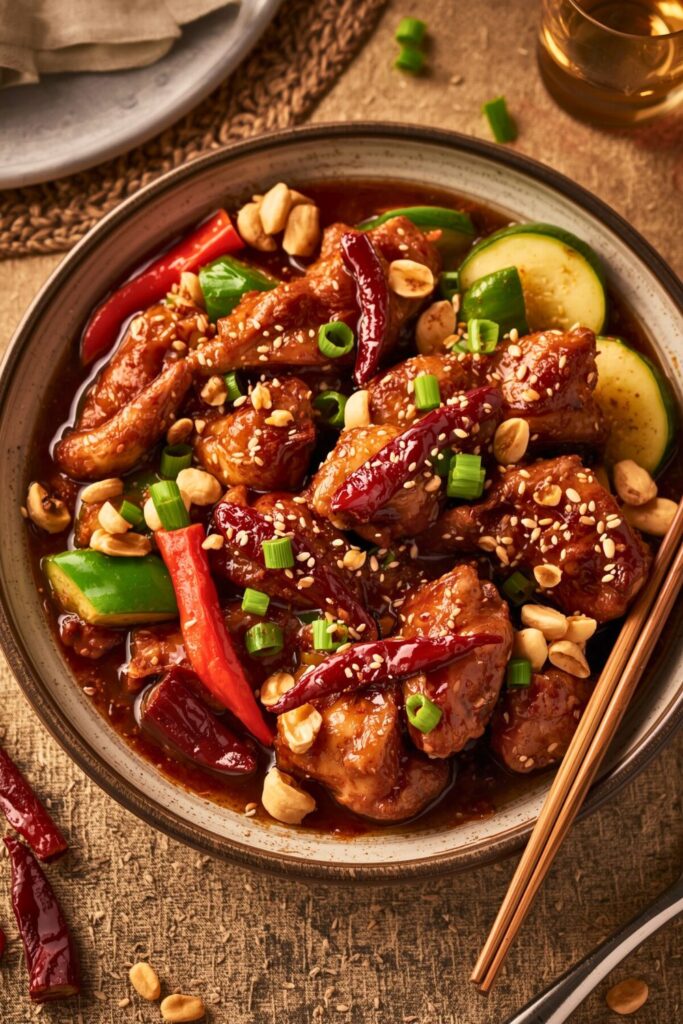
Let’s talk ingredients, and I’m gonna be real with you about what matters and what doesn’t.
For the chicken:
- 2 pounds boneless, skinless chicken thighs (trust me on this, breasts will dry out)
- 2 tablespoons cornstarch
- 1 tablespoon soy sauce
- 1 teaspoon sesame oil
For the sauce:
- 1/3 cup low sodium soy sauce
- 1/4 cup rice vinegar (not rice wine vinegar, they’re different)
- 3 tablespoons hoisin sauce
- 2 tablespoons brown sugar
- 1 tablespoon chili garlic sauce (adjust to taste)
- 1 teaspoon sesame oil
- 1 tablespoon cornstarch
The supporting cast:
- 4 cloves garlic, minced
- 1 tablespoon fresh ginger, grated
- 1 red bell pepper, diced
- 2 celery stalks, sliced diagonal
- 4-6 dried red chilies (or 1 teaspoon red pepper flakes)
- 3/4 cup roasted peanuts
- 3 green onions, sliced
Now, let’s talk swaps because I know not everyone has access to an Asian market.
Can’t find hoisin sauce? Mix 2 tablespoons soy sauce with 1 tablespoon peanut butter and 1 teaspoon brown sugar. It’s not exactly the same, but it’ll give you that sweet savory depth you’re after.
No rice vinegar? Apple cider vinegar works, though it’s a bit sharper. Use a little less and add a pinch of sugar to balance it out.
Chili garlic sauce missing from your pantry? Sriracha works in a pinch, or you can make your own by blending 2-3 fresh red chilies with a clove of garlic and a splash of rice vinegar.
Here’s something most recipes won’t tell you, the quality of your soy sauce matters enormously in this dish. Those $1 bottles from the grocery store are mostly salt and caramel coloring. Spend a few extra bucks on something like Kikkoman or San-J. Your taste buds will thank you.
Step by Step Slow Cooker Magic
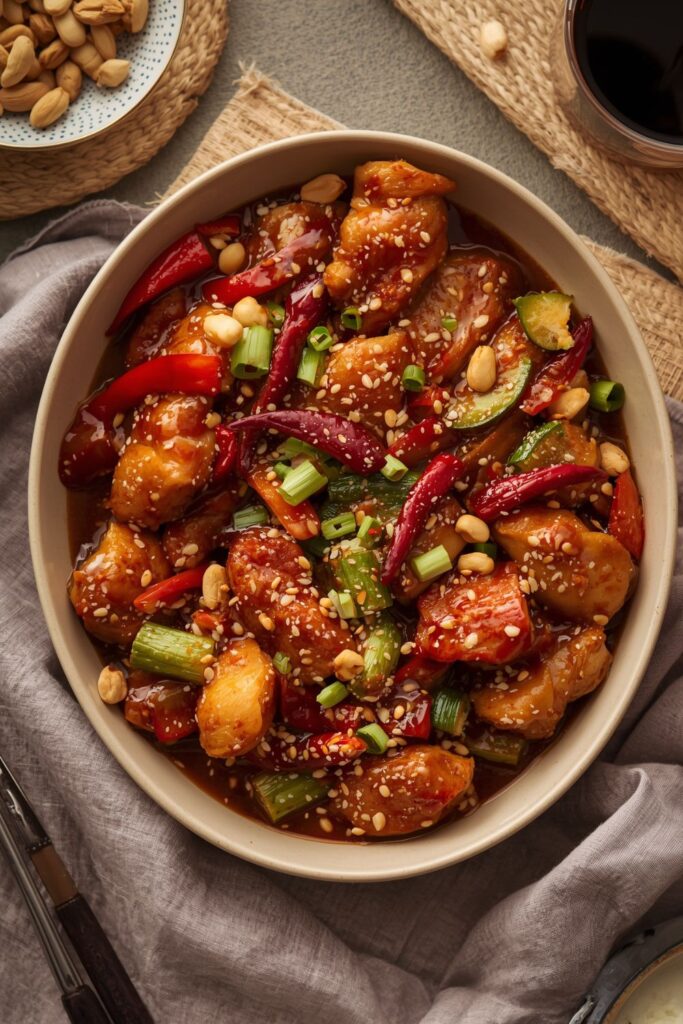
Step 1: Prep the chicken like a pro
Cut your chicken thighs into bite sized pieces, about 1 inch chunks work perfectly. In a medium bowl, toss them with cornstarch, soy sauce, and sesame oil. This isn’t just seasoning; it’s creating a protective coating that’ll keep the chicken tender during the long cooking process.
Let this sit while you prep everything else. The cornstarch needs time to hydrate and form that silky coating that’ll help thicken your sauce later.
Step 2: Build your flavor base
In your crockpot, whisk together all the sauce ingredients until smooth. Make sure that cornstarch is completely dissolved, any lumps now will be lumps later, and nobody wants gritty sauce.
Add the garlic, ginger, and dried chilies. These aromatics need the full cooking time to really permeate the dish. Don’t be tempted to add them later.
Step 3: The slow magic begins
Add your marinated chicken to the crockpot. Give it a gentle stir to coat everything in that beautiful sauce. Cover and cook on LOW for 3-4 hours.
Here’s where patience pays off. Don’t lift that lid every 30 minutes to check on things. Every peek releases steam and adds cooking time. Trust the process.
Step 4: Add the crunch
About 30 minutes before your cooking time is up, add the bell pepper and celery. This timing is crucial, too early and they’ll be mushy, too late and they’ll still be raw.
Stir gently and replace the lid. These final 30 minutes are when everything comes together.
Step 5: The finishing touches
Taste and adjust. Need more heat? Add extra chili garlic sauce. Too salty? A splash of rice vinegar will brighten things up. This is your moment to make it perfect.
Stir in most of the peanuts and green onions, saving some for garnish. The peanuts will soften slightly but still provide that essential textural contrast.
The Science Behind Slow Cooked Kung Pao
Let’s talk about why this method works so beautifully. When you stir fry kung pao traditionally, you’re working with intense heat for a short time. The chicken cooks quickly, the sauce reduces fast, and everything happens in minutes.
In the crockpot, we’re doing the opposite. Low, gentle heat breaks down the collagen in the chicken thighs, making them incredibly tender. The sauce has hours to develop complex flavors as the ingredients meld together.
The cornstarch coating on the chicken serves a dual purpose. It protects the meat from overcooking while also slowly dissolving into the sauce, creating natural thickening without that artificial feel you get from adding starch at the end.
Those dried chilies? They’re not just for heat. Long, slow cooking extracts their fruity, complex flavors that would get lost in high heat cooking. It’s like the difference between a quick sprint and a long, scenic walk, you notice more details when you slow down.
The timing of the vegetables is pure technique. Bell peppers and celery have different cellular structures than chicken. They need just enough heat to break down their tough fibers while maintaining their crunch. Too long, and you lose that textural contrast that makes kung pao so satisfying.
Plating Like a Pro and Perfect Pairings
Don’t just dump this beautiful creation into a bowl. Take 30 seconds to make it restaurant worthy.
Serve over steamed jasmine rice, but here’s the trick, make a little well in the center of your rice before adding the kung pao. It creates a natural boundary and looks infinitely more polished.
Garnish with those reserved peanuts and green onions, but also consider adding a sprinkle of sesame seeds or a few extra dried chilies for visual pop. A small wedge of lime on the side isn’t traditional, but that bright acidity is perfect for cutting through the rich sauce.
Wine pairing might seem weird with crockpot cooking, but hear me out. The sweet and spicy flavors love a slightly off-dry Riesling or Gewürztraminer. The residual sugar balances the heat while the acidity cuts through the richness.
Beer folks? Go for something with a bit of hop character, an IPA or even a wheat beer with citrus notes. The bitterness plays beautifully with the sweet savory sauce.
Side dish wise, keep it simple. Steamed broccoli, sautéed bok choy, or even just some pickled vegetables for acid and crunch. You don’t want to compete with the complex flavors you’ve spent hours developing.
Bringing It All Together
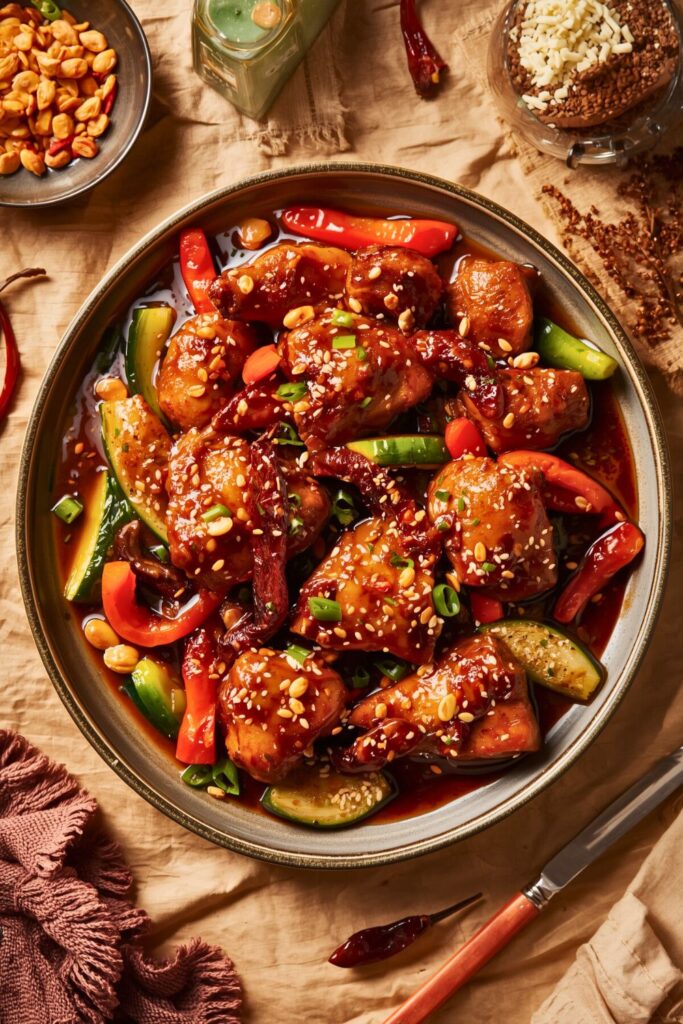
This Crockpot Kung Pao Chicken isn’t just about convenience, though it’s wonderfully convenient. It’s about understanding that great flavor doesn’t always require split second timing and high heat techniques. Sometimes the best results come from patience and letting ingredients do what they do best over time.
What makes this recipe worth your time is how it transforms a seemingly complicated dish into something approachable without sacrificing any of the complexity that makes kung pao special. You get that perfect balance of sweet, sour, salty, and spicy. You get tender chicken and crisp vegetables. You get the deep, nutty richness of peanuts and the aromatic heat of dried chilies.
But most importantly, you get a meal that feels special on a Tuesday night when you’re tired and hungry and want something better than another boring chicken dinner.
My final tips? Don’t skip the marinating step for the chicken, those few minutes make a real difference. Taste and adjust at the end, every palate is different. And don’t be afraid to make this recipe your own once you’ve mastered the basics. Extra vegetables, different nuts, more or less heat, cooking is supposed to be fun, not stressful.
Frequently Asked Questions
Can I make Crockpot Kung Pao Chicken with breasts?
You can, but I strongly advise against it. Chicken breasts dry out during long cooking times, even with cornstarch coating protection. If you must use breasts, reduce cooking to 2-3 hours and check doneness early. Thighs contain more fat and connective tissue. These break down beautifully in slow cookers, keeping meat incredibly moist.
How do I control the spice level?
This recipe delivers medium heat, noticeable but not overwhelming. Chili garlic sauce controls your heat level primarily. Start with one tablespoon for mild heat. Use two for medium spice. Go up to three for serious heat lovers. Dried chilies add aromatic heat over pure fire. Remove seeds if you’re heat sensitive.
Can I prep this the night before?
Absolutely perfect for meal prep! Marinate chicken and mix sauce separately overnight in refrigerator. Morning assembly takes just minutes, combine everything in crockpot and start cooking. Don’t add vegetables until final thirty minutes. They’ll get too soft with full cooking time.
What if my sauce seems too thin?
Taste first, thin hot sauce often thickens as it cools naturally. If it needs thickening, mix one tablespoon cornstarch with two tablespoons cold water. Stir this mixture in during final fifteen minutes. You can remove lid for final thirty minutes, letting liquid evaporate naturally.
How long will leftovers keep and do they reheat well?
Leftovers will keep in the fridge for up to 4 days and actually improve in flavor as the ingredients continue to meld. Reheat gently in the microwave or on the stovetop with a splash of water or chicken broth to loosen the sauce. The texture holds up remarkably well, though the vegetables will be slightly softer than when freshly made.

Swiftly Captions by Tina Smith — Quick, flavorful food recipes made simple, bringing fresh inspiration to your kitchen every day
